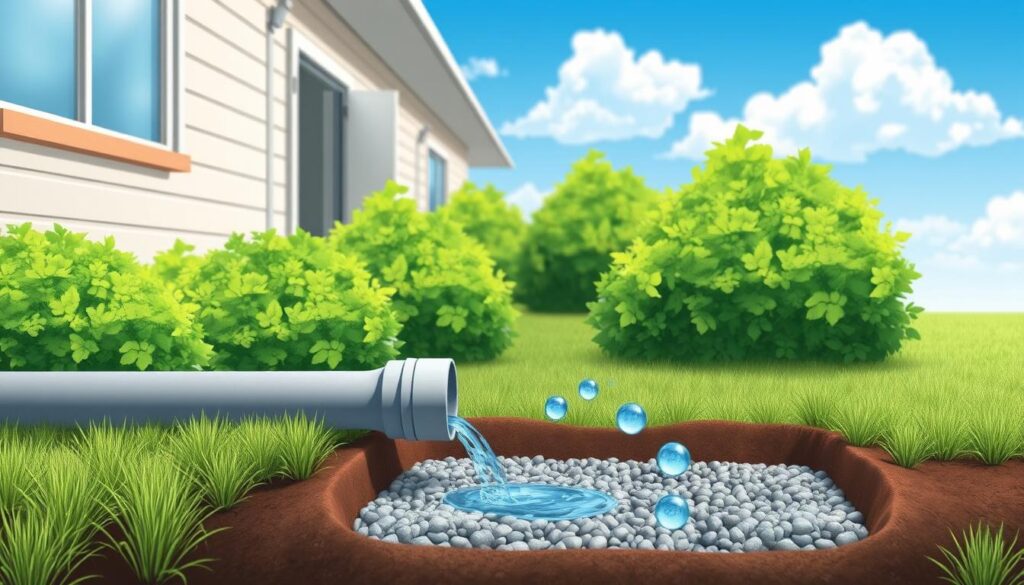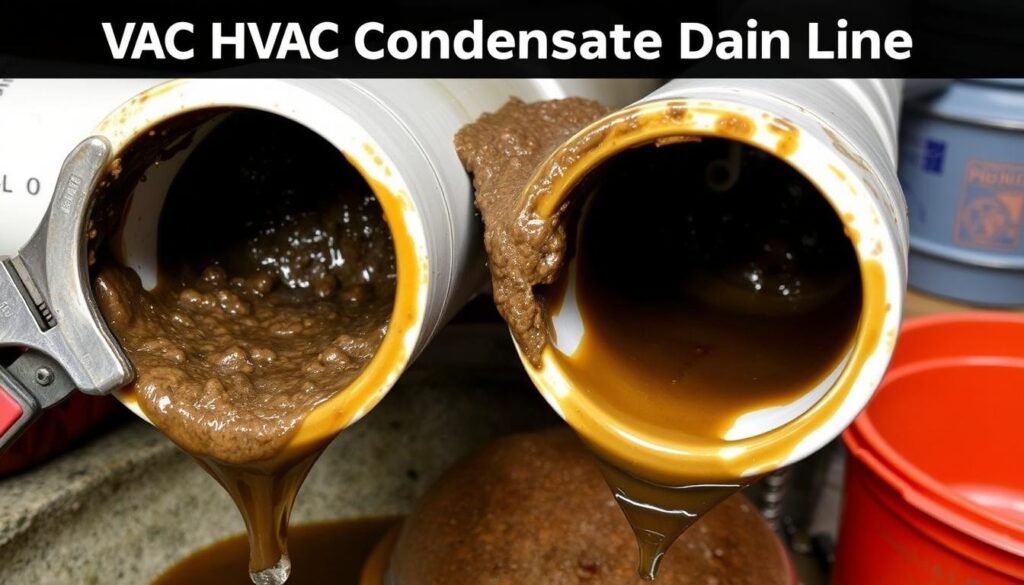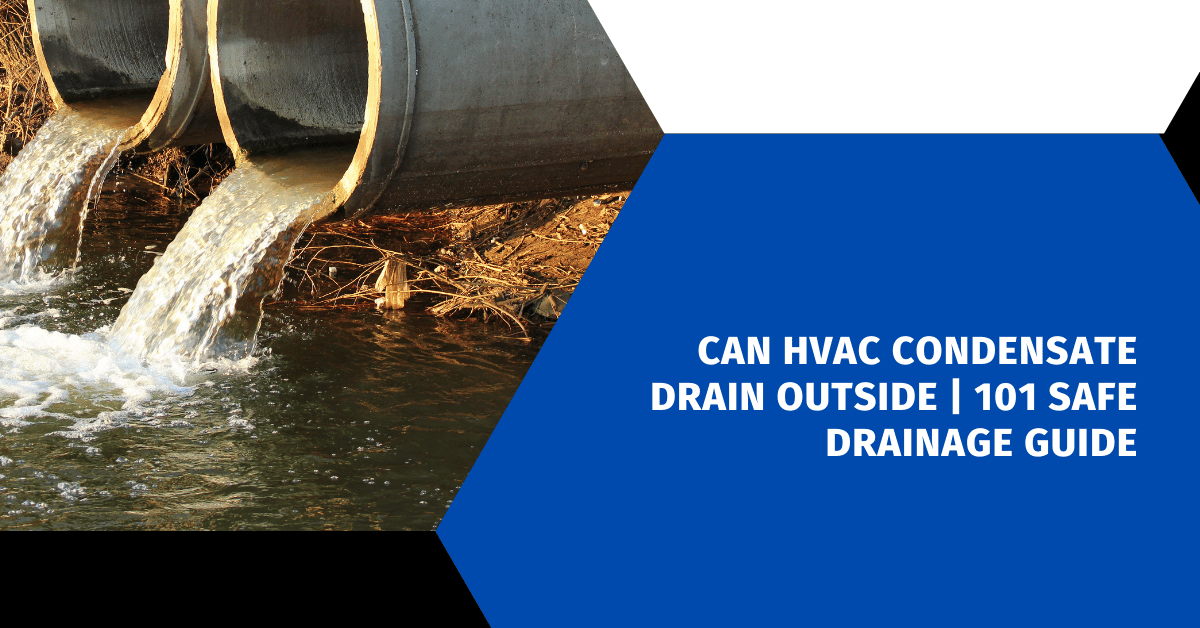Affiliate Disclosure
HVAC Guide Guys is a participant in the Amazon Services LLC Associates Program, an affiliate advertising program designed to provide a means for sites to earn advertising fees by advertising and linking to Amazon.
Can HVAC Condensate Drain Outside? Many homeowners and contractors wonder if they can drain HVAC condensate outside. It’s important to manage this condensate well. This keeps your system running smoothly and prevents water damage and mold.
In this guide, we’ll cover safe ways to drain condensate outside. We’ll talk about local rules, best practices, and safety steps. This ensures your HVAC system works its best.

Key Takeaways
- Understand the basics of HVAC condensate and its drainage requirements
- Explore the viability of draining HVAC condensate outside and the necessary precautions
- Learn about safe installation methods for exterior condensate drainage systems
- Discover common condensate drainage problems and their solutions
- Ensure compliance with local building codes and regulations
- Maintain your condensate drainage system through regular inspection and cleaning
- Protect your home and HVAC system from water damage and mold growth
Table of Contents
Understanding HVAC Condensate Drainage Basics
Keeping your HVAC system running well means knowing about condensate formation and HVAC drainage components. The water your air conditioner makes needs to be drained right. This stops water damage and keeps your system working great.
What is Condensate and Why It Needs Proper Drainage
Warm, humid air hits the cold coils in your HVAC. This makes water, called air conditioning condensate. It’s important to drain this water right. Otherwise, it could damage your home or hurt your HVAC’s electrical parts.
Components of a Condensate Drainage System
A condensate drainage system has a few main parts. There’s a drain pan to catch the water, PVC pipes to move it, and traps to stop backflow. Vents help with airflow too. Making sure these parts fit right and are installed correctly is key for good drainage.
Common Types of HVAC Systems Producing Condensate
Many HVAC systems, like air conditioners and furnaces with AC coils, make condensate when they work. This water collects in a drain pan under the air handler unit. Then, it goes through the drainage system to a safe place, like outside or into a floor drain.
| HVAC System | Condensate Production |
|---|---|
| Air Conditioner | High |
| Furnace with AC Coil | Moderate |
| Heat-Recovery Ventilator | Low |
Knowing about condensate formation, HVAC drainage components, and which HVAC systems make air conditioning condensate is vital. It helps keep your HVAC system working well and efficiently.
Explore Our HVAC Shop
Looking for top-rated HVAC tools, parts, and accessories? Visit our shop and find the perfect solution for your needs.
Visit the ShopCan HVAC Condensate Drain Outside
Managing HVAC condensate can be done by draining it outside your home. This method is safe and effective if it follows local building codes. It’s important to route the AC drain line to a spot away from your home’s foundation. Make sure it doesn’t connect directly to sewage systems to avoid contamination.
To set up a safe exterior drainage, an indirect drain with an air gap is needed. This setup prevents backflow and keeps your HVAC system and environment safe. By following the right installation steps and knowing local rules, you can handle your exterior condensate drainage and safe outdoor discharge well.
When looking at condensate disposal options, you have a few choices. Many people choose to send the condensate line to a gravel pit, dry well, or other approved spot. Others might connect it to a gutter or downspout system. It’s important to make sure the drainage works well and meets local codes.
“The majority of heating systems in this area are condensing units that will freeze up if a 1″ pipe is run through an exterior wall.”
Proper planning and execution are crucial for exterior condensate drainage. Knowing how to design and install a good condensate drainage system is key. This way, your HVAC system’s condensate can be safely and effectively discharged outside your home.
Explore Our HVAC Shop
Looking for top-rated HVAC tools, parts, and accessories? Visit our shop and find the perfect solution for your needs.
Visit the ShopSafe Installation Methods for Exterior Condensate Drainage
Installing your HVAC system’s exterior condensate drainage right is key. It ensures water is managed well and safely. For PVC condensate piping, picking the right materials and size is crucial. The drain line must have the right drain line slope for water to flow properly. Also, it’s important to add enough support and weather protection, especially in cold areas.
Proper Pipe Materials and Sizing
PVC piping is often used for condensate lines because it’s durable and affordable. Make sure to choose the correct pipe size based on your HVAC system and local building codes. Sealing the pipe connections well can prevent leaks and damage.
Slope and Support Requirements
- The drain line should have a minimum slope of 1/8 inch per foot to ensure proper water flow.
- Provide adequate support for the piping to prevent sagging, which can lead to water pooling and potential backflow issues.
- Use hangers or brackets to secure the pipe at regular intervals, as recommended by the manufacturer.
Weather Protection Considerations
- In areas prone to freezing temperatures, insulate the condensate line or consider routing it inside the home to prevent ice blockages.
- Protect the pipe’s exterior discharge point from the elements, such as by using a weatherproof cover or enclosure.
- Ensure the pipe’s end is directed away from the home’s foundation, walkways, or other areas where the water discharge could cause issues.
By following these safe installation methods for exterior condensate drainage, you can help ensure your HVAC system operates efficiently and effectively, while also protecting your home from potential water damage. Remember to always consult with a licensed HVAC professional for specific installation guidance and to comply with local building codes.
Indoor vs Outdoor Drainage Options
Homeowners face a choice when dealing with HVAC condensate: indoor or outdoor drainage. The decision hinges on the home’s design, local laws, and personal taste.
One indoor choice is linking the condensate pump to a floor drain. This is handy since it avoids outdoor line routing. Yet, it’s key to check local codes and avoid backflow or contamination risks.
Another option is to direct the condensate drain outside, like to a downspout or a special drainage system. This is good if indoor drains aren’t feasible. Yet, freezing in cold months and weatherproofing needs must be considered.
| Indoor Drainage | Outdoor Drainage |
|---|---|
|
|
The right choice between indoor and outdoor drainage depends on the home’s unique needs. Talking to a skilled HVAC pro can guide homeowners to the best exterior discharge solution.
Explore Our HVAC Shop
Looking for top-rated HVAC tools, parts, and accessories? Visit our shop and find the perfect solution for your needs.
Visit the ShopEssential Safety Measures for Condensate Lines
Keeping your HVAC system’s condensate drainage safe and efficient is key. It helps avoid problems like backflow, contamination, and system failures. To keep your condensate lines working well, you need to take certain safety steps.
Preventing Backflow and Contamination
Backflow and contamination are big concerns with condensate drainage. To fight these risks, you must put in an air gap between the condensate line and the drainage point. This air gap stops sewer gases from getting into your HVAC system, keeping your air clean.
Air Gap Requirements
The air gap needs to be at least 1 inch (2.54 cm) or twice the diameter of the condensate line, whichever is bigger. This ensures enough space and stops backflow. It’s vital to install the air gap correctly for condensate line safety.
Trap Installation Guidelines
You should also put a P-trap in the condensate line. The P-trap keeps a water seal that blocks sewer gases from getting into your HVAC system. Following the right P-trap guidelines is key to ensure it’s set up right and works well.
Connecting the condensate line directly to the drainage piping (Drain-Waste-Vent or DWV system) is often not allowed. This is because it can let sewer gas in. Proper venting and trap setup are essential for your HVAC system’s safety and efficiency.
“Regular maintenance of the condensate line is crucial for preventing water damage in homes and commercial buildings.”
Common Condensate Drainage Problems and Solutions
Keeping your HVAC condensate drainage system in check is key. It stops water damage, mold, and makes your system work better. But, issues like clogged condensate lines, algae growth, and wrong slope can still happen.
Clogged lines are a big problem. They get blocked by dirt, debris, and algae. This can cause water to spill over, damaging your home and letting mold grow. Cleaning and flushing the lines with a mild bleach solution can fix this.
Algae in the drainage system is another issue. The warm, moist place of the lines makes algae grow. This clogs the system and can make the air inside your home dirty. Using an algaecide or antimicrobial treatment can stop algae and keep the system running well.
Also, if the HVAC unit is not installed right, the drainage line might not slope properly. This can make water stay and cause clogs and backflow. It’s important to make sure the drainage pipes are sloped and supported correctly during installation.
Fixing condensate drainage problems quickly is important. Regular maintenance and checks on the drainage system can catch and fix issues early. This protects your HVAC and keeps your home’s air clean.

“Proper maintenance and periodic inspections are key to avoiding common drainage problems.”
Explore Our HVAC Shop
Looking for top-rated HVAC tools, parts, and accessories? Visit our shop and find the perfect solution for your needs.
Visit the ShopLocal Building Codes and Compliance Requirements
Understanding local building codes is key for HVAC condensate drainage. Different places have their own rules for installing and draining HVAC condensate. Homeowners and contractors need to check with local authorities to make sure their systems meet all codes and standards.
Permit Requirements
In many places, you need permits for HVAC condensate drainage installations or changes. These permits ensure the work follows local codes and safety rules. Without them, you might face fines, delays, or have to redo the work. Always check with your local building department before starting any HVAC projects.
Professional Installation Standards
Following HVAC codes is vital for safe and efficient condensate drainage systems. Professional standards require specific materials and methods to meet or beat industry standards. This prevents problems like backflow and contamination. To ensure your system is installed right, hire a licensed and experienced HVAC contractor.
| Key HVAC Code Compliance Requirements | Benefits of Code-Compliant HVAC Systems |
|---|---|
|
|
By following local HVAC code compliance and condensate drainage regulations, we ensure our HVAC systems are safe and efficient. Homeowners and professional installation contractors play a big role in creating a healthier environment.
“Proper HVAC code compliance and condensate drainage regulations are essential for ensuring the safety, efficiency, and longevity of our HVAC systems. Homeowners and contractors who prioritize professional installation and adherence to local standards are contributing to a healthier, more sustainable built environment.”
Explore Our HVAC Shop
Looking for top-rated HVAC tools, parts, and accessories? Visit our shop and find the perfect solution for your needs.
Visit the ShopMaintenance Tips for Condensate Drainage Systems
Keeping your HVAC system’s condensate drainage in top shape is key. Regular cleaning, stopping algae, and checking the system are musts. They help your drainage work right, avoiding expensive fixes later.
Drain Line Cleaning
Drain lines often get clogged with dirt, algae, and mold. To avoid this, flush them with distilled vinegar or hot water now and then. This clears out blockages and gets rid of extra junk.
Algae Prevention
The moist, warm spot of the condensate drain line is perfect for algae. Using a copper-based treatment can stop algae before it starts. This keeps your drain line open and avoids future problems.
Regular System Inspection
Check your HVAC system’s drainage often to catch issues early. Look for water in the drip pan, which means a clog. Always turn off the system’s power before you start to fix things to stay safe.
By sticking to these upkeep tips, your HVAC condensate drainage will work great. This means better air quality, temperature control, and energy use in your home.
| Maintenance Task | Frequency | Benefits |
|---|---|---|
| Drain Line Cleaning | Every 1-3 months | Prevents clogs, improves system performance |
| Algae Treatment | Every 6 months | Inhibits algae growth, maintains drain flow |
| System Inspection | Every 6 months | Identifies issues early, ensures safe operation |
Fixing condensate drainage problems fast can save you from big HVAC repair bills and water damage. If problems keep coming back, get help from a skilled HVAC tech.

Regular Inspection and Cleaning Procedures
Keeping your HVAC system’s condensate drainage healthy is key for its best performance and life span. Make sure to include regular inspections and cleanings in your HVAC maintenance schedule. This helps keep the condensate flowing well and avoids expensive problems.
Seasonal Maintenance Checklist
To keep your condensate drainage system working well, follow these seasonal tasks:
- Check the drain line for clogs or blockages. These can be from algae, dust, or dirt buildup.
- Look for cracks or corrosion in the drain pan that might cause water leaks.
- Make sure the drain line is sloped and supported right. This helps water flow freely.
- Use tools like portable air compressors or wet-dry vacs to clean the drain line and pan.
Signs of Drainage System Problems
Regular drainage system inspection helps spot and fix issues early. Watch for these signs of trouble:
- Water leaks around the HVAC unit
- Visible mold or mildew growth
- Musty odors from the system
- Lower HVAC efficiency or performance
Fixing these problems quickly can save you from expensive repairs. It also keeps your HVAC system running smoothly.
“Regular inspections and cleaning of the condensate drainage system are essential for maintaining the overall health and efficiency of your HVAC unit. Neglecting these tasks can lead to serious problems down the line.”
By sticking to a detailed HVAC maintenance schedule and watching for drainage system problems, you protect your investment. This ensures your home stays comfortable all year round.
Conclusion
Managing HVAC condensate drainage is key for your system’s health and your home’s safety. It’s important to follow safe drainage practices and local building codes. This ensures your HVAC system works well and safely.
Regular maintenance helps avoid problems like clogged lines and frozen coils. It also stops too much condensate buildup. This keeps your system running smoothly and protects your home from damage.
Don’t overlook the importance of HVAC condensate management. It keeps your heating and cooling systems running efficiently for years. By following safe drainage practices, you’ll enjoy reliable HVAC and reduce risks from bad condensate handling.

